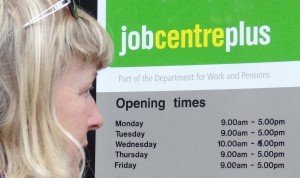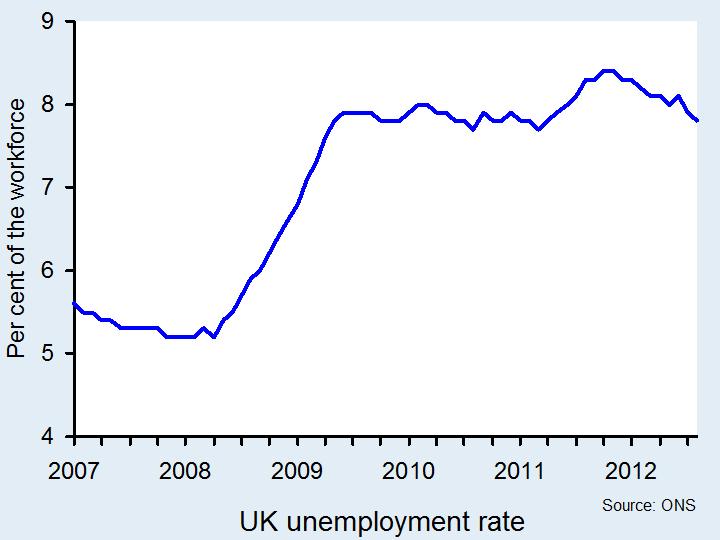 UK Unemployment figures for the July to September period have just been published. Perhaps surprisingly, the rate has fallen to 7.8% from 8.0% in the previous 3-month period. What is more, there have been similar 0.2 percentage-point falls in each of the two 3-month periods prior to that (see chart below).
UK Unemployment figures for the July to September period have just been published. Perhaps surprisingly, the rate has fallen to 7.8% from 8.0% in the previous 3-month period. What is more, there have been similar 0.2 percentage-point falls in each of the two 3-month periods prior to that (see chart below).
This would normally suggest that the economy has been growing strongly and faster than the growth in potential output. But, despite positive economic growth in quarter 3 (see A positive turn of events?), the economy has been experiencing a prolonged period of low or negative growth.

So what is the explanation for the fall in unemployment? (For a PowerPoint of the chart, click here)
One reason is a greater flexibility in the labour market than in previous recessions. People are more willing to accept below inflation wage increases, or even nominal wage cuts, in return for greater job security. Others are prepared to reduce their hours.
The other reason is a fall in productivity (i.e. output per hour worked). One explanation is that people are not working so hard because, with a lack of demand, there is less pressure on them to be productive; a similar explanation is that firms are ‘hoarding’ labour in the hope that the market will pick up again.

Another explanation is that employment growth has often occurred in the low productivity industries, such as labour-intensive service industries; another is that when people leave their jobs they are replace by less productive workers on lower wages; another is that workers are making do with ageing equipment, whose productivity is falling, because firms cannot afford to invest in new equipment. An range of possible explanations is given on page 33 of the Bank of England’s November 2012 Inflation Report.
But with many predicting that growth will be negative again in 2012 quarter 4, the fall in unemployment may not continue. Britain may join many other countries in Europe and experience rising unemployment as well as falling output.
Articles
Government hails fall in jobless total The Guardian, Hélène Mulholland (14/11/12)
UK unemployment figures: analysis The Guardian, Larry Elliott (14/11/12)
Jobless claims rise as Olympics effect wanes The Telegraph, Rachel Cooper and Louisa Peacock (14/11/12)
UK unemployment falls to 2.51 million, ONS says BBC News (14/11/12)
 Unemployment continuing to fall BBC News, Stephanie Flanders (14/11/12)
Unemployment continuing to fall BBC News, Stephanie Flanders (14/11/12)
Britain’s recession: Harsh but fair? BBC News, Stephanie Flanders (17/10/12)
The UK productivity puzzle (cont’d) BBC News, Stephanie Flanders (20/9/12)
UK jobs: The plot thickens BBC News, Stephanie Flanders (15/8/12)
Data
Unemployment: the key UK data and benefit claimants for every constituency Guardian Data Blog
Labour Market Statistics, November 2012 ONS
 Video Summary: Latest on the Labour Market, November 2012 ONS
Video Summary: Latest on the Labour Market, November 2012 ONS
Labour Productivity, Q2 2012 ONS
International Comparisons of Productivity, First estimates for 2011 ONS
Questions
- What possible explanation are there for the latest fall in unemployment?
- What has been happening to employment, both full time and part time?
- What are the different ways of measuring productivity? Why will they be affected differently by a fall in the average number of hours worked?
- Why might it be in firms’ interests to maintain the level of their workforce despite falling sales?
- Assume that there has been a fall in aggregate demand. Compare the resulting effect on consumption of (a) a fall in wages rates; (b) a rise in unemployment. How might the design of the benefit system affect the answer?
UK unemployment now stands at 2.47 million, which is a fall of 34,000 people in the three months to May. Meanwhile, the claimant count, which measures the number of individuals claiming Jobseeker’s Allowance, fell by 20,800 between May and June to stand at 1.46 million.
The total number in employment increased by some 160,000 in the three months to May to reach 28.98 million. The increase in the number of individuals in work is largely due to an increase in the number of part-time workers, which now stands at some 27%. The development of the flexible firm has played a huge role in creating more and more part-time jobs.
Although declining unemployment is good news, and the jobless rate of 7.8% is now comparable with the EU and the US, there are suggestions that it may rise again next year. Indeed, unemployment is expected to peak at nearly 3 million in 2012 (10%) and an employer’s group has said that the UK may face serious job deficits for the next decade. As more and more jobs are lost in the public sector, estimates suggest that the economy must grow by 2.5% per year from now until 2015, in order to compensate these losses with extra jobs in the private sector.
As John Philpott, the Chief Economic Adviser at the CIPD said:
“A slightly milder growth outcome – which many would consider a decent recovery in output given the various strong headwinds at present facing the economy – is easily as imaginable as the OBR’s central forecast and would leave unemployment still close to 2.5 million by 2015, meaning Britain faces at least half a decade of serious prolonged jobs deficit.”
So, although the fall in the jobless rate is undoubtedly good news, the uncertain future for unemployment in the UK, will put a slight dampener on this news.
Articles
UK unemployment declines to 2.47m BBC News (14/7/10)
Economy Tracker BBC News (14/7/10)
Unemployment to peak at 3m by 2012 Telegraph (14/7/10)
Labour market report to show outlook for jobs worse than OBR projections Guardian, Katie Allen (14/7/10)
Part-time work boosts UK employment rate Sky News, Hazel Tyldesley (14/7/10)
Unemployment figures: what the experts say Guardian, Katie Allen (14/7/10)
Data
Labour market statistics latest: Employment ONS
Labour Market Statistical Bulletin – July 2010 ONS
Labour market statistics: portal page ONS
Questions
- How is unemployment measured in the UK? Which is the most accurate method?
- What is the flexible firm and how has it allowed more part-time jobs to be created?
- Why is unemployment expected to rise again in the next few years?
- The ONS has reported that wage growth has eased sharply. How will this, along with falling unemployment rates, affect household incomes and consumption? Will one effect offset the other?
- Brendan Barber in the Guardian article, ‘Unemployment figures – what the experts say’, wrote that unemployment lags behind the rest of the economy. Why is this?
- What type of unemployment are we experiencing in the UK? Illustrate this on a diagram.
- Consider the government’s plans in terms of spending cuts. How are they likely to affect the rate of unemployment in the UK?
The latest ONS labour market release reveals that in the three months to April the number of people unemployed in the UK was 2.472 million, up by 23,000 on the previous three months (i.e. the three months to January). The rate of unemployment – the number of people unemployed expressed as a percentage of those economically active – nudged upwards to 7.9% from 7.8% in the previous three months.
In a previous article A labour challenge for Osborne we considered the possibility that some of the emerging patterns in the labour market numbers could act as an impediment on the future potential output of the UK economy. The latest figures seem to offer little obvious comfort in this respect. Here, we note three causes for possible concern.
Firstly, we note the continued rise in inactivity. Of those of working age, inactivity rose by a further 29,000 in three months to April to stand at 8.186 million. This is an historic high and equates to 21.5% of the potential working population.
Secondly, we note the continued rise in long-term unemployment. The number of people unemployed for more than one year rose by 85,000 in the three months to April to stand at 772,000. This compares with 399,000 in the same three month period in 2007, just as the first clear signs of the impending financial crisis were being drawn to the public’s attention. In other words, this measure of long-term unemployment has effectively doubled since the financial crisis. But, more than this, 31.2% of those unemployed have been so for at least one year.
Thirdly, we note the high levels of youth unemployment. In the three months to April the number of unemployed people aged 18-24 was 713,000. This was down on the previous three months, but by a mere 2,000. The unemployment rate amongst 18-24 year-olds is 17.3% which is more than double the overall unemployment rate of 7.9%.
Aside from the very obvious personal costs of unemployment and of inactivity, each of these labour market issues poses important economic challenges for the country and its policy-makers. These are difficult challenges at the best of times. But, they could hardly be more difficult given the current national and international economic environment and, of course, the tendency for fiscal consolidation both at home and abroad.
Articles
Unemployment: public sector feels the pain as jobless hits 2.47 million Telegraph, Harry Wallop (16/6/10)
Unemployment: what the experts say Guardian (16/6/10)
Unemployment rises as public sector shrinks Financial Times, Brian Groom (16/5/10)
UK unemployment rises to 2.47 million BBC News (16/6/10)
 Unemployment levels a ‘challenge’ for government: Interview with Work and Pensions minister, Chris Grayling BBC News (16/6/10)
Unemployment levels a ‘challenge’ for government: Interview with Work and Pensions minister, Chris Grayling BBC News (16/6/10)
Data
Latest on employment and unemployment Office for National Statistics (16/6/10)
Labour Market Statistics, June 2010 Office for National Statistics (16/6/10)
Labour market statistics portal Office for National Statistics
For macroeconomic data for EU countries and other OECD countries, such as the USA, Canada, Japan, Australia and Korea, see:
AMECO online European Commission
Questions
- Evaluate the possible consequences for the UK economy, both now and in the future, of: (i) high and rising levels of inactivity; (ii) high and rising levels of long-term unemployment; and (iii) high levels of youth unemployment.
- Again, thinking about the issues of labour market activity, the duration of unemployment and youth unemployment, what policy recommendations would you make in trying to tackle them?
- If you were writing this blog in a year’s time, what would you expect will have happened to levels or rates of inactivity, long-term unemployment and youth unemployment? Explain your answer.
- Again, if you were writing this blog in a year’s time, would you expect to find any other emerging patterns in labour market statistics? Explain your answer.
 UK Unemployment figures for the July to September period have just been published. Perhaps surprisingly, the rate has fallen to 7.8% from 8.0% in the previous 3-month period. What is more, there have been similar 0.2 percentage-point falls in each of the two 3-month periods prior to that (see chart below).
UK Unemployment figures for the July to September period have just been published. Perhaps surprisingly, the rate has fallen to 7.8% from 8.0% in the previous 3-month period. What is more, there have been similar 0.2 percentage-point falls in each of the two 3-month periods prior to that (see chart below). Unemployment continuing to fall BBC News, Stephanie Flanders (14/11/12)
Unemployment continuing to fall BBC News, Stephanie Flanders (14/11/12) Video Summary: Latest on the Labour Market, November 2012 ONS
Video Summary: Latest on the Labour Market, November 2012 ONS
